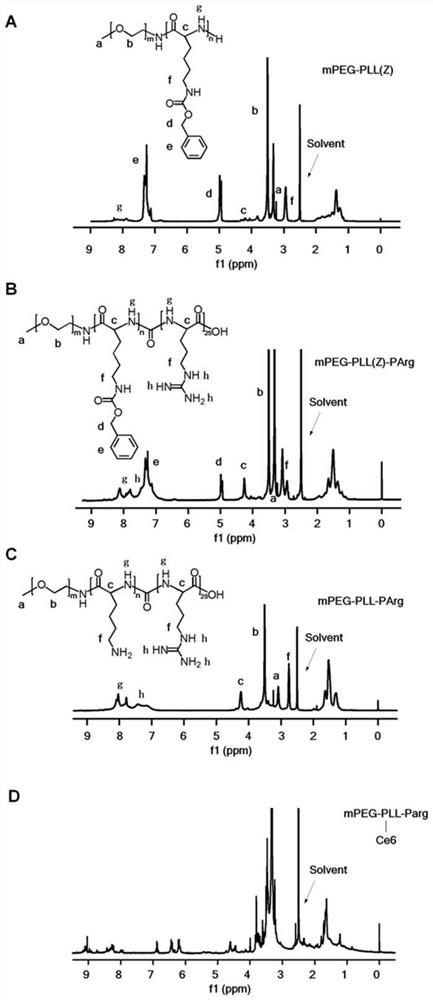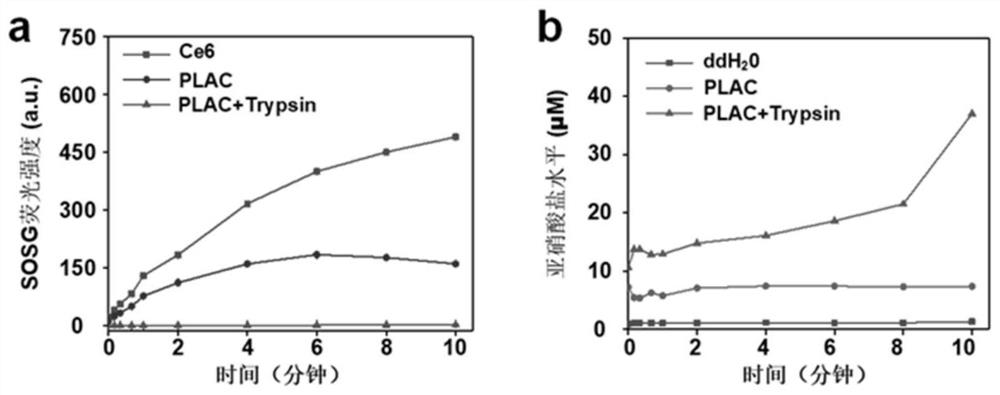Construction of photosensitive nano-micelle capable of inducing M1 type polarization of tumor-associated macrophages and anti-tumor application of photosensitive nano-micelle
A macrophage, tumor-related technology, applied in the construction of photosensitive nanomicelles and its anti-tumor application, can solve the problems of immune-related adverse reactions, low tumor selectivity, poor water solubility, etc., and achieve enhanced killing efficacy and better treatment. effect of effect
- Summary
- Abstract
- Description
- Claims
- Application Information
AI Technical Summary
Problems solved by technology
Method used
Image
Examples
Embodiment 1
[0069] The preparation of the nano system for photodynamic sensitization and induction of immune response, the specific steps are as follows:
[0070] (1) polyethylene glycol (mPEG-NH 2 , molecular weight 2000) (218 mg, 0.11 mM) was dissolved in 3 mL of anhydrous tetrahydrofuran (THF) as a macroinitiator. Then, Lys(Z)-NCA (N6-benzyloxycarbonyl-L-lysine cyclic anhydride, CASNo.: 1676-86-4) (1 g, 3.27 mM) was dissolved in 5 mL of anhydrous N,N-di Methylformamide (DMF), and the Lys(Z)-NCA solution was added to the mPEG-NH2 solution with a syringe under argon. The reaction mixture was stirred at 35° C. for 3 days under the protection of dry argon, and then the obtained product was precipitated into excess glacial ether, filtered, and vacuum-dried to obtain mPEG-PLL (Z).
[0071] (2) 4-Nitrophenyl chloroformate (70.5 mg, 0.35 mmol) dissolved in 5 mL of dichloromethane was added to pyridine (39 μL, 0.58 mmol) dissolved in 1 mL of dichloromethane at 0°C. Then mPEG-PLL(Z) (0.75 g, ...
Embodiment 2
[0077] The nano system synthesized in embodiment 1 is characterized:
[0078] 1. The product obtained in steps (1), (3), (4) and (5) is passed through nuclear magnetic resonance 1 Confirmed by H-NMR, the results are as follows figure 1 shown.
[0079] 2. Treat the nanomicelle PLAC@R848 synthesized in step (6) with trypsin (typsin, McLean) (final concentration 1mg / mL) in a shaker at 37°C for 24h, and at 98°C for 5min to deactivate the trypsin Live, compared with no trypsin treatment in a shaker at 37°C for 24h, through transmission electron microscopy (TEM), nanoparticle size and Zeta potential analyzer (DLS, Zeta potential), ultraviolet-visible spectrophotometer (UV-Vis) , Fluorescence spectrometer to characterize the nanomicelle PLAC@R848 before and after enzymolysis, using the product PLA obtained in step (4) as a control, the results are as follows figure 2 shown.
[0080] 3. The ability to produce ROS and NO of the nanomicelle PLAC synthesized in step (5) was confirme...
Embodiment 3
[0084] Investigate the generation of polymer micelle PLAC obtained by the method of Example 1 in 4T1 cells ROS and NO, and its influence on tumor cell HSP70 expression, the specific steps are as follows:
[0085] 1. Use DCFH DA as a fluorescent probe to observe the generation of ROS. Using 4T1 cells (Kunming Cell Bank of the Typical Culture Collection Committee of the Chinese Academy of Sciences) as a model, add polymer micellar PLAC (the concentration of ce6 in PLAC is equivalent to 150 μg / mL) Trypsin (final concentration 150 μg / L) was incubated at 37°C for 24h, and then at 98°C for 5min to inactivate trypsin. The 4T1 cells were divided into 6 groups and subcultured in the confocal dish for 48 hours. After the culture medium was removed, each group was added with PBS buffer (Control group), PBS buffer (Laser group), ce6 (ce6+Laser group), PLAC, PLAC ( PLAC+Laser group), enzyme-treated PLAC (incubated with trypsin aqueous solution at a final concentration of 1mg / mL at 37°C for...
PUM
 Login to View More
Login to View More Abstract
Description
Claims
Application Information
 Login to View More
Login to View More - R&D
- Intellectual Property
- Life Sciences
- Materials
- Tech Scout
- Unparalleled Data Quality
- Higher Quality Content
- 60% Fewer Hallucinations
Browse by: Latest US Patents, China's latest patents, Technical Efficacy Thesaurus, Application Domain, Technology Topic, Popular Technical Reports.
© 2025 PatSnap. All rights reserved.Legal|Privacy policy|Modern Slavery Act Transparency Statement|Sitemap|About US| Contact US: help@patsnap.com



